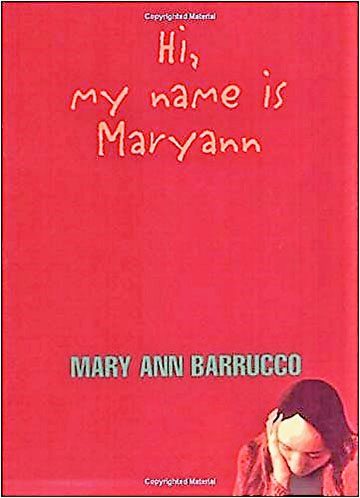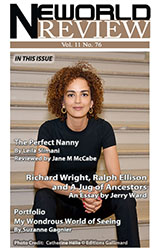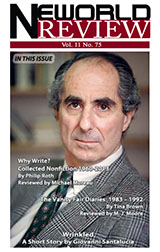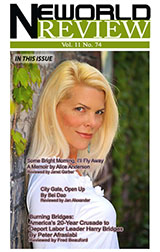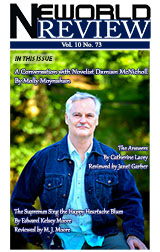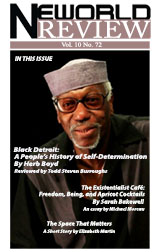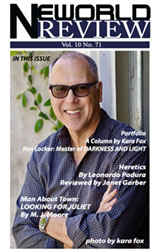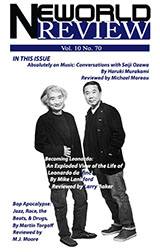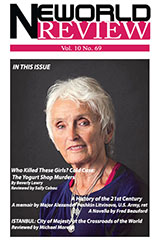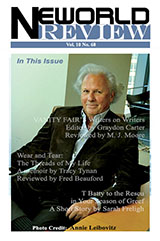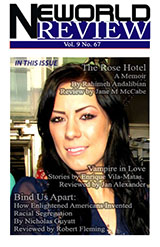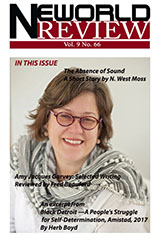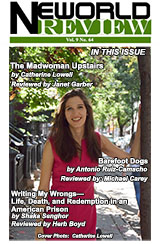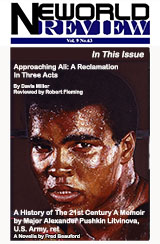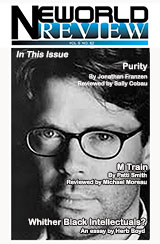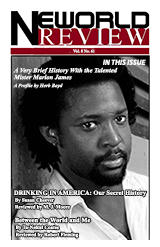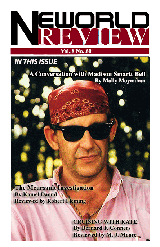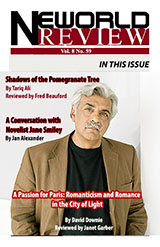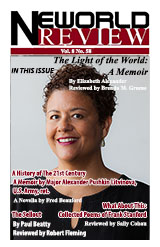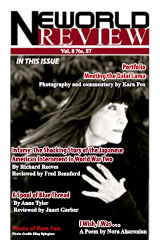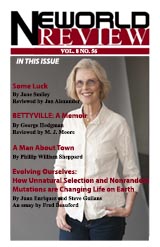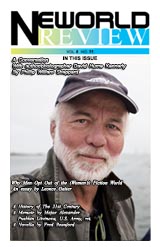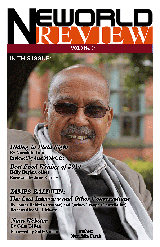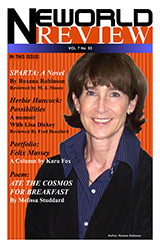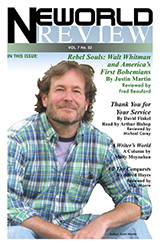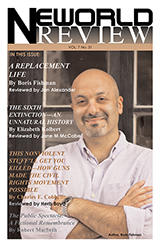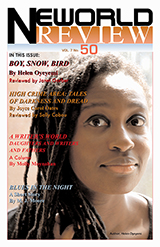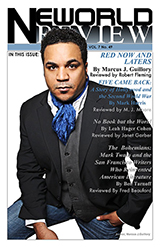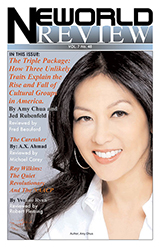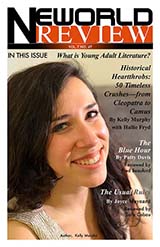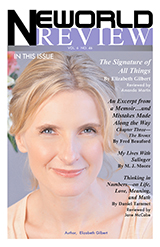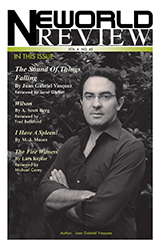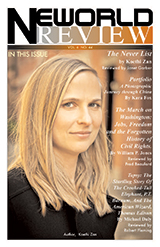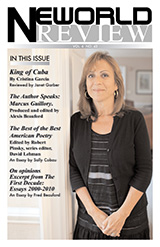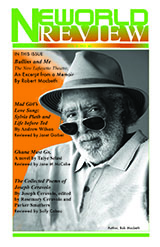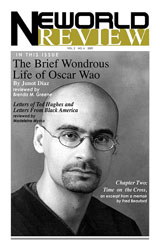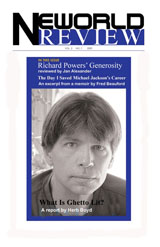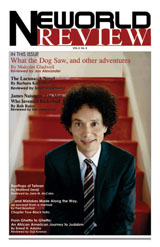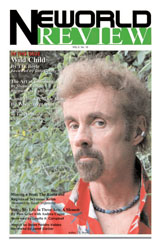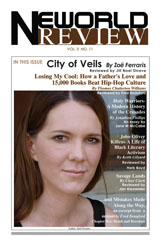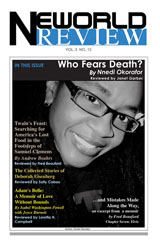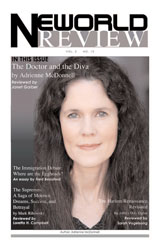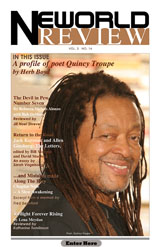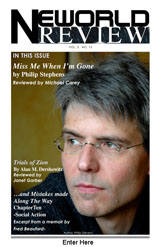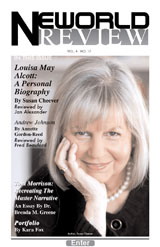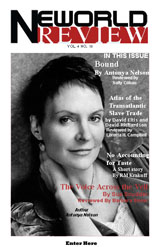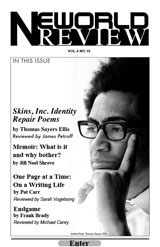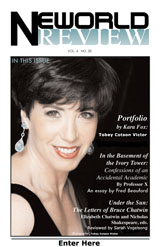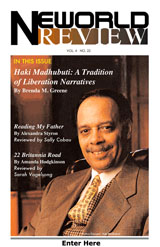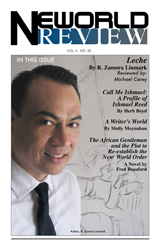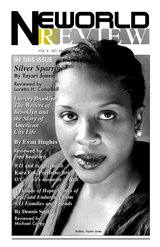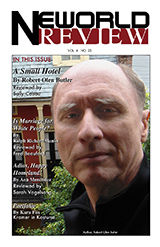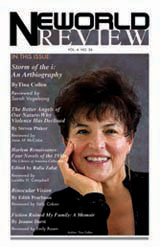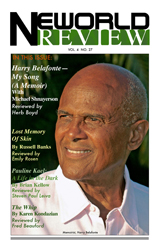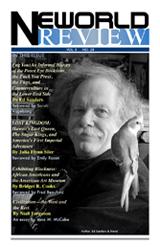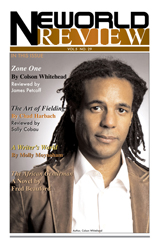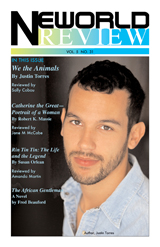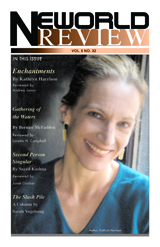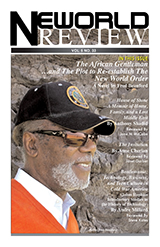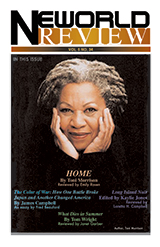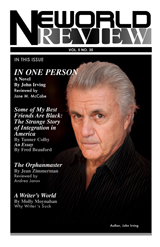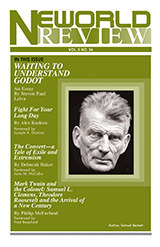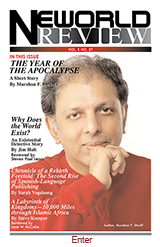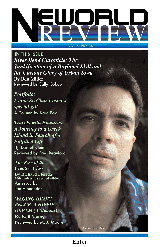
Letter to the Reader:
Disrupters Revisited: Where is Walter Lippmann when we need him?
In issue 74 of my Letter to the Reader, I pointed out that until several key disrupters came into being in full force in the ‘90s, the consolidation of the media in this country was on the fast track to turn America into a plutocracy, where a tiny, well-organized group with a ton of money rules over what we read in magazines, newspapers and books, see on television and the movies, listen to on radio and recordings, and what we were allowed to say in places of higher learning.
What happened, however, was the disrupters I mentioned (and a few I didn’t) did what disrupters always do, they disrupted. Now, in as little as twenty years later, we see the results of this clearly, mainly, because of all things, the election of New Yorker Donald Trump to the presidency of the United States (a New Yorker being elected to the White House is shocking in itself).
You must be one of the walking blind not to see the full court press that the once mighty liberal media are throwing at President Trump. I personally have never seen such sour looking folks on television as I see on CNN. To use yet another cliché, they are throwing everything, including the kitchen sink at the President, and it’s not working!
Trump’s supporters stand steadfast, and they continue to give the liberals the finger.
The last time this same group decided to give the boot to a president was in the ‘70s. The unfortunate Richard M. Nixon, who they hated as much as they now hate President Trump, didn’t stand a chance after he was found lying about his knowledge about Watergate.
With Nixon, it was print and newscast television that did him in. Coordinated attacks by CBS, NBC and ABC, The Washington Post and the New York Times offered sensational story after story about Nixon’s malfeasances. August commentators, both in print and on the air, weighed in and offered compelling arguments as to why Nixon must go.
The famous, and feared Walter Lippmann must have been pleased, as he died that same year, 1974, when Nixon was forced to resign from office. Lippmann had been a renowned journalist and commentator, a media critic and an amateur philosopher, who tried to reconcile the tensions between liberty and democracy in a complex and modern world. His words in his newspaper columns were almost Godlike.
***
In the next few decades, as Journalism professors grumbled into their greying beards to no avail, most knowing well that Nixon’s “Silent Majority,” and Americans of all strips had grown tired of two trying decades of assassinations, starting with President Kennedy, the endless Vietnam War, the civil rights movement, the anti-war movement and the “Long Hot Summers” of deadly and destructive race riots taking place in almost every major city in the country.
Most of America now just wanted a break from too much reality—as the liberal media slowly consolidated, after years of trying, television, movies, newspapers, books, recordings and magazines. Michael Eisner, then the CEO and Chairman of Disney from 1984-2005, said it best: “We now have synergy.”
My eyebrows went up when I read that, because it sounded a lot like “vertical integration”, which the Supreme Court called a monopoly in 1948 and came down hard on the Hollywood studios, who had by then controlled the production and distribution of film and controlled most of the movie theaters nationwide.
Writes author Scott Bomboy, “The major studios had a near monopoly on the movie business in the United States. Each studio had exclusive contracts with actors and directors; owned the theaters where their movies played; worked with each other to control how movies were shown in independent theaters; and in some cases, owned the companies that processed the film.
"The system of “vertical integration” was expensive to maintain, but it was lucrative when the movie business was booming.”
The Supreme Court, however, finally stepped in, and forced the Moguls to give up their theaters, and, in the end, give up the contract system with actors and director.
But the synergy that Eisner bragged about meant that now movie studios like Disney could now acquire network television companies, and every media outlet that he, and others of his ilk, could lay their greedy, power hunger hands on, thanks to ongoing deregulations from the Federal Communication Commission (FCC) that begun with President Ronald Reagan. Soon, the airways no longer “belong to the people,” if they in fact ever did.
Now that the Hollywood/Manhattan collective had what they lusted for, for decades, what did they do with this new power? The answer was to gut the news departments of the networks, just allowing for things that just couldn’t be ignored; and to make everything on television about Hollywood and “Pop News,” with the print media following their lead.
Actors and pop music stars now ruled once interesting and diverse shows like The Today Show and Good Morning America. It also brought forth the strange era of nonstop Brad, Jen, Angie, and countless others. The Walter Lippmanns of the world disappeared from public life, and over the years “Pop News” was the only news that counted, other than bad weather, and other natural disasters, and what was happening in the Mideast. This was only interrupted once by 9/11. But shortly after that, it was Brad, Jen and Angie all over again.
Needless to say, the new Moguls became filthy rich, and one crowed in one of their newspapers in Los Angeles, that “we control the narrative in this country.”
But a disrupter called Fox News slowly gain ground, as social media and blogs, and, dare I say, online magazines like Neworld Review, started bringing other ideas into existence besides what Brad Pitt had for lunch.
The Liberal media did not have any Walter Lippmann’s left to set everything in its proper place.
In the end, all they had were the late-night comedians, which year after year, they had steadily weaponized, so that by the election of Donald Trump, a toilet mouth Stephen Colbert dropped an A bomb at President Trump that did not destroy him as hoped, but instead took down any trace of decency left by the liberal media that had egged him on and have still not fired him.
This is a great issue. Thank you, once again, for clicking on to us.
Fred Beauford
Editor-in-Chief
Publisher
Neworld Review
Vol. 11 No 78 - 2018
Editor-in-Chief
/Publisher
Fred Beauford
Online Managing Editor
Richard D. O'Brien
Associate Editor
Jane M. McCabe
Fiction Editor
N West Moss
Editor-at-Large
Jan Alexander
Senior Editors
Molly Moynahan
Herb Boyd
M.J. Moore
Janet Garber
Director of Photography
Kara Fox
President
Alexis Beauford
Contributing Writers
Larry Baker
Todd Steven Burroughs
Michael Carey
Sally Cobau
Steve Fisch: Portfolio
Robert Fleming
Michael Moreau
Emily Rosen
Jane Smiley
The Neworld Review is a publication of Fred Beauford, 47 Stewart Ave,
Irvington, NJ. 07111.
Material in this publication may not be reproduced in whole or in part without permission. Opinions expressed by contributors do not necessarily reflect the views of the publishers.
Manuscripts should be accompanied by a self-stamped envelope. Online submissions are accepted. Contact Us
Neworld Review cannot be held responsible for unsolicited photographs or manuscripts.
All correspondence to:
Fred Beauford
Editor-in Chief/Publisher
Neworld Review
47 Stewart Ave,
Irvington, NJ 07111
Contact Us
This Month's Articles
REVIEWING
1983: Reagan, Andropov, and a World on the Brink
By Taylor Downing
Da Capo Press | 2018 | 400 pages
Reviewed by Fred Beauford
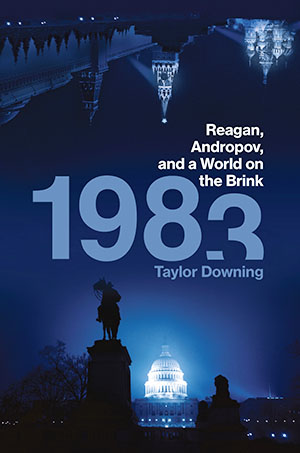
Scary Stuff
When I was just a teenager I can remember thinking that because I lived in New York City, I am going to one day, perhaps soon, witness a bright flash of light and be already dead before I get to hear the enormous roar that is right behind that blinding light. So far, years later, I still walk the streets of New York City, and it is as intact and full of life, even more so, as it was years ago.
However, author Taylor Downing book, 1983: Reagan, Andropov, and a World on the Brink, gave me the chills as he described how I, and millions other, almost got fried.
This segment from his prologue says it all: “This [book] highlights…the story of the 1983 war scare when the Soviets convinced themselves that the United States was preparing to launch a nuclear first strike against them… It shows how minor and unpredictable events can rapidly escalate into major confrontations. And it climaxes with a night on which the Soviet nuclear arsenal was put on to maximum alert, when missiles were deployed to action stations… If these missiles had been fired it would have prompted a nuclear exchange that would have destroyed much of North America, most of Asia, probably all of Europe. The fallout would have brought down a nuclear winter that would have covered Earth for years or decades to come. The death toll would have been counted in the hundreds of millions, dwarfing every conflict in human history.""
How did this nightmare come about? Taylor Downing gives us a riveting account in this book, but first we have the two men who held the fate of the world in their hands: President Ronald Reagan of the United States of America and General Secretary of the Communist Party of the Soviet Union, Yuri Andropov.
Reagan had recently turned 70, then the oldest man to run for president, and Andropov was 68, when General Secretary Leonid Brezhnev, died on November 10, 1982, and he was chosen by a handful of elderly men who ran the Soviet Union. Andropov also, like with President Reagan, was the oldest man elective to hold this leadership position.
Most of world knew a great deal about President Reagan: Radio, movie and television star; two-term Governor of the great American state of California, and finally, President of the United States of America. And he was one of the loudest out spoken voice against “godless Communism,” and the “evil empire” of the Soviet Union.
By contrast, outside of Russia, few knew anything about Andropov. Author Downing points out that “In the 1970s and 1980s, Western observers of events behind closed doors of the Politburo and the Central Committee of the Communist Party of the Soviet Union were known as Kremlinologists.”
These “experts” were taken aback when “a pale, stooping elderly man in heavy glasses stepped forward.”
However, Andropov was as strong as Reagan in his deeply held belief in Marxism/Leninism. He joined the Young Communist League at the age of sixteen. Then Joseph Stalin was the leader of the Soviet Union and Adolf Hitler was about to ravage Russia and most of Europe. Andropov rose quickly through the ranks, until in May 1967 he was appointed head of the famed, and deeply feared KGB, a huge organization with perhaps a half a million employees. It controlled spy missions both domestic and worldwide.
In that sense, it was wise for the master spymaster, to keep a.....Read More

REVIEWING
Nothing is Forgotten (A Novel)
By Peter Golden
Reviewed by M. J. Moore
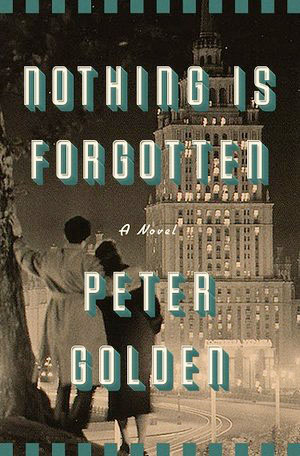
All the Forgotten Faces
Aside from its literary integrity, narrative power, and other qualities, the title of Peter Golden’s new novel, Nothing is Forgotten, is worthy of attention. Why?
Because recent news stories have highlighted that a significant portion of Americans think that either the Holocaust did not happen or that the number of Holocaust victims—especially Jewish victims—is far smaller than what has been documented and reported since 1945.
In other words, in the America of 2018, apparently, everything can be forgotten.
However, novelist and journalist Peter Golden has committed all of his talent as an author toward one goal: storytelling that is steeped in carefully researched history.
Yet, this is far more than what’s commonly called a “historical novel.” Instead, this novel blend mystery, coming-of-age motifs, Cold War cultural signposts and a rich sense of yearning for family members lost in World War Two. The alchemy of the novel is brilliantly mixed by Peter Golden, who lets details emerge in the dialogue of his characters, as well as in his narrator’s first-person ruminations and the spoken monologues of other main characters.
It all begins, innocently enough, in South Orange, New Jersey, where Chapter 1 comes to life with this clear, relaxed opening paragraph: Narrator Michael Daniels tells us: “I was never too interested in my family’s history. My indifference wasn’t just the apathy of a kid bored by school and obsessed with rock ‘n’ roll; it was because my father and his mother, Emma Dainov, preferred not to talk about it.”
From there, Golden’s narrator takes readers back to the halcyon postwar days of America in the late 1950s – when early rock ‘n’ roll was the new soundtrack of youth and the Second World War concluded for well over a decade. Nonetheless, the war never ends in the traumatized minds and souls of those who survived it – and that lingering gloom, that ever-present dark shadow, dominates this unique story.
In fact, a constant oscillation from suburban innocence to grim experience gives.....Read More

POEM
We are Commissioned for Greatness
A Poem by Tanya Manning-Yarde

We were from that exhalation of
Ether and ethos,
Fusing and spooling
Ancestral imaginings into
Seedlings seeking soil, unfolding
Into roots, absorbing, charged to
Burrow deep into Mother Earth’s mouth,
Soak in every watering word.
Obliging study of the bark and
Tutorials from leaf veins creating food for the body,.....Read More

REVIEWING
So Where Are We?
City of Our Dreams
By Lawrence Joseph
Reviewed by Sally Cobau

I want to talk about the poetry collection So Where Are We? by Lawrence Joseph. I have only lived in big cities for short periods of time, and I have never lived in the city of all cities: New York. So, I do not know the street names Joseph frequently refers to or the restaurants, cafes. However, the intimacy with which he describes the landscape is virile and alive; it’s as if he is describing a long friendship.
I don’t think it’s without care that Joseph’s poems often focus on the natural—the elemental—parts of the city. Barges and waterways. A sliver of sky painted violet (consciously painted by himself, the poet). The “Hudson River, black and still.” “The landscape turns yellow…” This homage to nature, entwined in the moving, pulsing world is reminiscent of poet’s past and reminded me specifically of Walt Whitman, although the feeling of the poems are quite different.
Seeing nature for New Yorkers may be more “significant” than for someone like me, because from my perspective nature is abundant—I look out the window, view endless sky and a field where the cows have left because they’ve eaten all the grass (the cowboys have moved them once again). I feel sorry for people who live in cities sometimes because they are not immersed in the natural world. And I’m sure they also feel sorry for me…
In his opening poem, “A Fable,” Joseph writes about water:
“Great bronze doors of Trinity Church, hours
told by the sounds of bells. A red
tugboat pushes a red and gold barge
into the Narrows. A bench in the shadows…”<
The humble barge is a common motif in So Where Are We? The poems are hinting at a different time when goods were transported by water rather than transported in the nether realm of cables and computers. This metaphysical stance—what are we as humans now? —what are our goods, if not coffee, tea, and spices? Mere bytes and megabytes—a hustling manipulation of cyber entities? —infiltrate the book. The poems are about our cultural identity and highly evocative: So, where are we?
Where are we as a country now? (I scan the Op/Ed section and find this: “Is the United States Too Big to Govern?” asks one op/ed contributor.) Our country has grown so unwieldy that at times it does seem impossible to govern. And yet we communicate in a blink of an eye. We are connected as a country—as a world-with astonishing speed, and yet our tissue is cancerous.
So Where Are We? traces our discomfort back to 9/11. It also poses a more piercing question: Where are those who got killed in 9/11? Joseph writes:
“So where are we The fiery
avalanche headed right at us—falling
flailing bodies in midair—
the neighborhood under thick gray powder—
on every screen. I don’t know…”
The lines beg the question: where were you when this tragedy happened? How were you affected, frozen into this time, like the bodies jumping from buildings, frozen on our screens, with the mind-numbing crystallization of truth of this magnitude burrowing into our skulls, forming us, changing us.
The victims are ash, vaporized. That’s where the.....Read More

REVIEWING
Black Swans
Eve’s Hollywood
Slow Days, Fast Company
By Eve Babitz
Reviewed by Michael Moreau

Eve Babitz asked me to dance once, but I rebuffed her.
It was at the Pasadena Ballroom Dance Association where she had been invited to sign her new book on the tango, and I waited in line to also ask her to autograph my copies of Slow Days, Fast Company and Eve’s Hollywood, two of her earlier books that I revered, and when I reached the table and set them down, she said something like “Oh, yes, I remember these,” and I probably gushed out something like, “I love these books.” She said, “We’ll have to dance later,” and I said something like “Sure. I look forward to it.”
But I knew I couldn’t ask her to dance. A girlfriend who was a swing devotee had coaxed me to come to the PBDA dances that offered lessons before the main event, but I literally didn’t know my right foot from my left. And I couldn’t bear the thought of mistakenly trying to lead the writer I admired so much in a fox trot while the music signaled a waltz. It all seemed so incongruous that Babitz, the consummate chronicler of 1970s and 1980s Hollywood and hip Westside L.A. should be signing books in this drab hall behind a Lutheran church in unhip Pasadena.
She may have wound up dancing with a NASA's Jet.....Read More

POEM
THE WEDDING
A Poem by Rob Morton
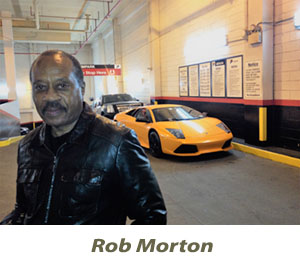
The pain and the reverent beauty of it.
Beauty, because it radiated, everywhere.
Emanating from both the bride and the groom – more so from the bride.
She is given the title of Duchess yet she radiates the air of a Queen – Queen Meghan.
This air of royalty made all the more pungent.....Read More

REVIEWING
My Girls: A Lifetime with Carrie and Debbie
By Todd Fisher
Reviewed by David Bruce Smith

A son's affectionate memoir of growing up with a famous mother and sister.
When a relationship comprises three interdependent people, it can be inherently flammable — and emotionally asymmetrical.
According to Todd Fisher’s new memoir, My Girls: A Lifetime with Carrie and Debbie, he and his beloved best friend/confidante/for-keeps sister interpreted life very differently. Carrie Fisher was prickly, penetrating, and pernicious, while Todd was inclined to be mellow, measured, and matter-of-fact.
Early on, Carrie perceived a jittery household dynamic that Todd — at first — didn’t recognize. It was disguised by alcohol, over-the-top parties, and an endless current of glittering guests who included Jimmy Stewart, Frank Capra, Judy Garland, Cary Grant, Eva Gabor, Groucho Marx, Bette Davis, Lucille Ball, and mother Debbie Reynolds’ closest friend, Agnes Moorehead.

Carrie and Todd were children of a well-publicized divorce that absorbed the world. Their father, singer Eddie Fisher, abandoned Reynolds for Elizabeth Taylor. Though Carrie was too young to recall the extensively played-out event, it is likely the loss was imprinted given future disappointments and no-shows from Fisher, who remained a wispy presence in her life until his end. Reynolds tried to counter, cushion, and compensate for the familial calamity with more than ample love:
“Mom really was incredible since Carrie and I were born, about doing everything in her power to make sure we were included in her life as much as possible. She never sequestered us or treated us like accessories to be trotted out for photo shoots and then handed back to a team of nannies like so many other ‘show-biz’ kids we knew.”
In 1960, Reynolds married Harry Karl, retired president of the Karl Shoe Stores chain. He lived in listless, laidback luxury and regularly played high-stakes poker and golf at Hillcrest Country Club with his influential.....Read More

PORTFOLIO
Portfolio: A Column by Kara Fox

Frozen in Time: A PHOTOGRAPHY RETROSPECTIVE
A photograph, seemingly still, contains an energy, a power. The photographer, as the artist, sees, captures that moment, and consciously or sub-consciously freezes it. That moment represents a moment of the moment, not actually the moment itself. In that instant, there now exists an intersection between what was, what is and how the viewer interprets what they are seeing and feeling.
My dear father photographed everything—the happy, the sad, parties, holidays, travels, accidents and even funerals. He wanted that imprint on our lives. Still, today, I recall much of my life through the lens of his camera, in....Read More

SHORT STORY
Nutley
A Short Story by David Galef

Sorry if I bumped into you. Excuse me. My name is Greg. Gregory R. Santoro. Resourceful inventor of gadgets and gear. Live in Nutley. I don’t really—hey! Okay. Catch you later.
Pardon my elbow. Didn’t see you coming. Now don’t give me that look. Don’t give me that. Let’s begin again. My name’s Greg. Gregory R. Santoro, inventor—all right, no harm done, right? Why would you say that? Not going to say sorry twice. You, too.
Oops, sorry about that. Let me help you pick everything up. Greg, Gregory R. Santoro. The R. is for Ronald. I’m an inventor, actually. My home’s in Nutley. Pleased to meet you, Jim. Funny you should ask that. Sure. Let me buy you a cup of coffee to replace the one I made you spill. No, I’ve got some time.
Here’s a Starbucks. They know me here. Park yourself at that table over there, and I’ll be back with the coffee in a minute.
As I said, I’m an inventor. Gadgets and gear. I tell that to everyone I meet. You wanna know why, Jim?
When I was a kid, my mother bought me this dorky wool cap that smelled like a sheep whenever it got wet. Useless. Flash forward fifteen years, one cold winter when I was traveling light. I had this concept for a travel hat that could be worn three different ways, depending on the weather: sun, rain, cold. The Santoro Three-Way. Catchy, huh? Didn’t know how to take it further. Got no connections in the garment industry. I’m not even much of a draftsman. I work for the post office in Nutley. There’s a business that could use some new ideas.
Last year, I heard about this agency, BizAid, that helps jumpstart people with products they wanna push. They were handing out flyers across from the post office. Had to fill out a form, and then they explained the arrangement. A little odd, I thought, but why not?
Want a cookie? My treat. I recommend the chocolate chunk.
So. There’s a place called Claude’s Café in Hackensack, and they tell me someone’ll be there to discuss my idea. Gave me his name, Fishbein, and a description: guy in his sixties with a spade beard, wearing a blue parka. I show up on time, look around. It’s an elegant place, but practically empty. Just a gentleman at a corner table—I say “gentleman” because he’s wearing a tailored suit, with the kind of haircut he got from a salon I’ll never get to. Out of my league. But he’s there and I’m there, and since my guy hasn’t shown up—I waited half an hour—I start talking to him.Turns out he’s a promoter looking for promising ideas to push. Who’d have thought? And he’s interested in my ideas. My ideas! I’ve also got a couple of gadgets for the disabled, like an expander ring to hold open a sock so you can slide your foot in it. The Sock-It-to-Me! Anyway, I talk to him—I’ve got time—and he asks some intelligent questions. Talks in a debonair voice, sorta like James Bond. I leave the café with the guy’s card in my pocket and an agreement to follow up.
BizAid contacts me to see how it went. They need me to fill out another form: how long I spent there, whether anything unexpected happened, and some other stuff. I could be annoyed at them, considering how I was stood up, but now I’ve got a story to tell them, almost too good to be true.
That’s right. It wasn’t true. He was a plant! Some actor they hired for a social psychology experiment. With me as the guinea pig. I should be mad! Do I sound mad? Wasn’t just me. There were plenty of other marks—okay, subjects. But unlike the determined entrepreneur that I am, they just waited a while, and when the right person didn’t show up, they got out of there.
They said I was the only one who stayed.
They gave me a debriefing. When I told them I was disappointed, no one to invest in my ideas, they said that’s not the point. That it could’ve been real. You never know. That people make their own luck. That I was right to reach out, to talk to strangers.
You’ve got no money, I get that, but it was worth a shot, right? You try again and.....Read More

POEM
Astral
for Leonora Carrington
A Poem by Melissa Studdard

Her soul was folklore
and her body was the shadow of alphabet
written backwards in secret code.
I will try to tell you a story:
how the lamp of her
arrived before she did, a ghost
among the masks and tapestries at market—
invisible tongue of quartz, hands like jellyfish,
mouth of inner shell. And how delicate the silver thread
that led back to the flesh-protected skull.
.....Read More

